principle of an IGBT module
IC IGBT Modules are power semiconductor devices that are used to control current in a wide variety of applications. IGBT modules are capable of sustaining a high voltage in the range of hundreds of volts, making them perfect for use in industrial applications.
To understand how IGBT module work, you should first have a general understanding of the structure and working principle of bipolar transistors. Then, you will be able to better understand the relationship between IGBT, BJT and MOSFET. Easybom will explain the basic structure and working principle of an IGBT module one by one in a simple and easy-to-understand way.

An insulated gate bipolar transistor (IGBT) is a power semiconductor device that combines the advantages of both a bipolar transistor and a MOSFET. It has the same current-carrying capabilities of a bipolar transistor but has the advantage of higher blocking voltages and faster switching speeds than a MOSFET. This combination of features makes IGBTs ideal for medium-speed switching applications.
Can you explain the basic structure and working principle of an IGBT module?
IGBTs are constructed with four layers of semiconductor sandwiched together. The layer closest to the collector is the p+ substrate layer. Above this is the n-layer, and inside the n layer is another p layer. A metal-oxide-semiconductor (MOS) gate is placed on top of these layers and is insulated from the other semiconductors by a layer of silicon dioxide. The three terminals of an IGBT are the gate, collector and emitter.
When an IGBT is turned on, it conducts current through the n-drift region (shown as the yellow dotted line in the picture above). When the gate drive voltage VGE is applied to the IGBT, electrons will flow from the n-drift region into the p+ injection region and then into the channel. This will cause the p+ injection region to start emitting minority carriers into the n-base region. The channel will then begin conducting current from the p+ injection region to the n-drift region.
During the turn-off of an IGBT, it takes time for the stored charge to dissipate. This is the reason why IGBTs have a characteristic waveform with two segments: td(off) and trv(f). During this time, the drain current has a negative slope until the stored charge completely dissipates. Then, the drain current begins to rise again until it reaches its maximum value.
Unlike other power semiconductor devices, IGBTs are characterized by their low turn-off resistance and high gate drive current. This allows them to achieve much higher switching speeds than traditional bipolar transistors and has a significant impact on the efficiency of industrial drives. IGBTs can be used in a wide variety of applications including power supplies, motor controls, variable speed drives and solar DC-AC inverters. They offer good performance in a variety of temperature ranges and are rated for continuous current up to 1200A. IGBTs are also available in a wide variety of packages to accommodate different application requirements. This includes small-profile modules with a surface mount design for smaller footprints and tighter control of power losses.
Jinftry (JING FU CAI (HONGKONG) INTERNATIONAL CO., LIMITED) is a global professional one-stop procurement and service provider of electronic components. It uses independent distribution, platform distribution combined with the Internet online sales model to sell various products worldwide. Types of electronic components, providing one-stop component procurement and supply chain services to global OEM factory customers and brokers. Sales include integrated circuits, discrete semiconductors, IGBT modules, connectors, capacitors, diodes, transistors and other electronic components, covering power supply, automotive, communications, computers, consumer products, medical, industrial, mobile phone and other application fields.
Jinftry product line cards: TI, ONSEMI, Microchip, Maxim, NXP, STM, Xilinx, Intel, Infineon, Broadcom, Renesas, samtec, Souriau, CISSOID, Mitsubishi, FUJI, Semikron, etc.

Website: https://www.jinftry.com
Shenzhen Operation Center Address: 26F1, Building C, Electronic Technology Building, Shennan Middle Road, Futian District, Shenzhen, Guangdong, China
Hong Kong company name: JING FU CAI (HONGKONG) INTERNATIONAL CO., LIMITED
Registered address of Hong Kong company: Unit No.A222,3F,Hang Fung Industrial Building,Phase2,No.2G Hok Yuen Street,Hunghom,Kowloon,Hong Kong
Email: [email protected]
Tel: +86-755-82518276